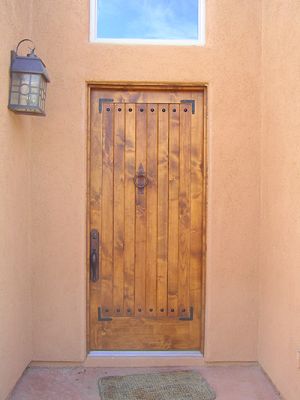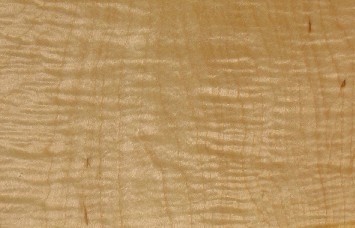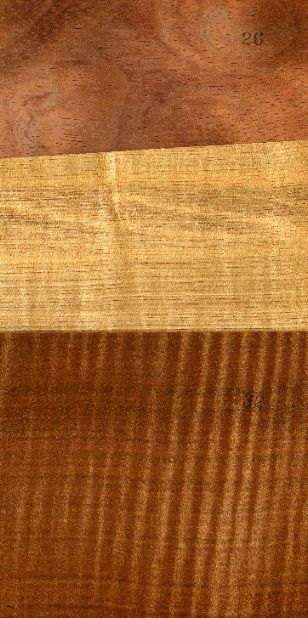Question
I've got a new table to stain and was told it was made of alder. I have never worked with alder before. Does it take stain well? Anything to watch for? I will be spraying a water base stain.
Forum Responses
(Finishing Forum)
From contributor D:
Alder is prone to blotching. If you want a clean, even stain job, you need to use a washcoat on the wood first, followed by a light sanding, then you can stain it. If you're looking for the rustic look, just go ahead and stain it. In the picture below, you can see an alder door I made for someone that I did not use a washcoat on. You can see all the darker areas where the stain was absorbed a lot more than other areas.

However, it blotches more like pine than maple, and that greyness gives it the cheap rustic look, while ruining the grain figure. Further, no two boards stain identically, so too many colors cheapen the look.
Proper finishing requires a well sanded surface, to 220 at least, and a strong wash coat before staining.
I've found alder looks better with lighter stains. The browns only add to the rustic effect. I've had success toning first with aniline dye in a light yellow/slightly brown hue to even the boards out and figure the grain, then staining with reddish browns. But the colors are not as important as removing the blotching. As you can see, I'm a big alder fan - it has great depth when done right.
As for alder, here in SoCal, it's probably the most common wood used for cabinets. I see more alder come through my shop than any other. Been that way for years. I believe what contributor M said about figure and blotching is applicable to alder.
If it's an aniline, it will highlight any grain/figure of your table. If that's what you're looking for, great - if not, you could glaze/tone to even it out.
Two points to add to all the above well informed posts. Grain and figure are two different things. Most alder sold does not come from large trees, so one gets a lot of stock that is cut close to knots, so the growth rings are rarely straight grained. When one applies a stain to grain that is not parallel to the surface of the board, and is almost end grain, the stain absorbs much faster, and darker areas are seen, such as the door in the photo (which is a great looking door to me). Some customers want the Formica look, so some jobs require 100% same color on a project, hence washcoats.
When I washcoat and dye, it is specifically to avoid the "near end grain" to which you refer, which is the cause of some of the greying and blotchy effect so prevalent in alder. I hope most finishers are aware what "figuring the grain" refers to, and that is highlighting the unique growth patterns, and minimizing effects from poor milling, or defaults incumbent in rapid growth species.
The door above is a good example of how the wood finishes if you don't take steps to keep the coloring even. And that's the rustic look that was desired, so it works well. Nice door!
I think contributor C made a good point about the difference between grain and figure as well as using a washcoat to even out the coloring. Of course, sap stains, toners, glazes, and shading stains can also be used, as needed, to get even coloring with varying effects. I can't say I've heard of "figuring the grain," but in my area we probably have another name for it... something like "finishing."
In this sample of curly maple, the curly figure runs horizontally and the grain of the wood runs vertically.

When contributor C says "grain and figure are two different things," it makes sense to me and I usually explain it the same way. If you have a favorite finish(es) for cherry, the same finish(es) will likely look great on alder. At the link below, I described the steps I used to finish a TV armoire that had alder doors, poplar trim, and birch ply panels.
http://www.woodweb.com/knowledge_base/Staining_and_Blending_Difficult_Woods.html
I would say that rustic is more an element of design, not the uneven coloring of the door. The hardware lends itself more to rustic, and no doubt the overall design of the house. Otherwise, I'd better tell my wife that the entertainment center I built and finished (very uneven coloring) for our contemporary home using some wild curly maple is really "rustic" :)

A washcoat (about 3% solids) works well if you insist on using a wiping stain. The washcoat should be this thin so that it soaks deeply into the alder, which is a very soft wood. Also, the best wiping stains we've found for use with alder are those made by General Finishes (Prelude). Alder is the only wood we can get here in Phoenix that's very high quality, as all of the cherry currently being shipped in completely sucks. Stained well, the stuff in truly beautiful and comparatively cheap. Highly recommended.